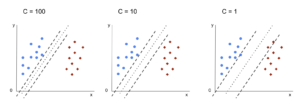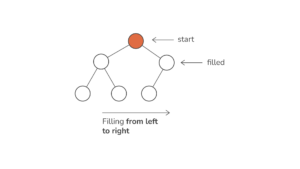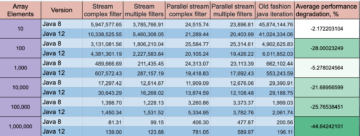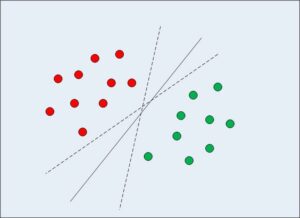Introduction
As a data analyst, it is our responsibility to ensure data integrity to obtain accurate and trustworthy insights. Data cleansing plays a vital role in this process, and duplicate values are among the most common issues data analysts encounter. Duplicate values can potentially misrepresent insights. Therefore, it is crucial to have efficient methods for dealing with duplicate values. In this article, we will learn how to identify and handle duplicate values, as well as best practices for managing duplicates.
Identifying Duplicate Values
The first step in handling duplicate values is to identify them. Identifying duplicate values is an important step in data cleaning. Pandas offers multiple methods for identifying duplicate values within a dataframe. In this section, we will discuss the duplicated() function and value_counts() function for identifying duplicate values.
Usin duplicated()
The duplicated() function is a Pandas library function that checks for duplicate rows in a DataFrame. The output of the duplicated() function is a boolean series with the same length as the input DataFrame, where each element indicates whether or not the corresponding row is a duplicate.
Let’s consider a simple example of the duplicated() function:
import pandas as pd data = { 'StudentName': ['Mark', 'Ali', 'Bob', 'John', 'Johny', 'Mark'], 'Score': [45, 65, 76, 44, 39, 45]
}
df = pd.DataFrame(data) df_duplicates = df.duplicated()
print(df_duplicates)
Output:
0 False
1 False
2 False
3 False
4 False
5 True
dtype: bool
In the example above, we created a DataFrame containing the names of students and their total scores. We invoked duplicated() on the DataFrame, which generated a boolean series with False representing unique values and True representing duplicate values.
In this example, the first occurrence of the value is considered unique. However, what if we want the last value to be considered unique, and we don’t want to consider all columns when identifying duplicate values? Here, we can modify the duplicated() function by altering the parameter values.
Parameters: Subset and Keep
The duplicated() function offers customization options through its optional parameters. It has two parameters, as described below:
-
subset: This parameter enables us to specify the subset of columns to consider during duplicate detection. The subset is set toNoneby default, meaning that each column in the DataFrame is considered. To specify column names, we can provide the subset with a list of column names.Here is an example of using the subset parameter:
df_duplicates = df.duplicated(subset=['StudentName'])Output:
0 False 1 False 2 False 3 False 4 False 5 True dtype: bool -
keep: This option allows us to choose which instance of the duplicate row should be marked as a duplicate. The possible values for keep are:"first": This is the default value for thekeepoption. It identifies all duplicates except for the first occurrence, considering the first value to be unique."last": This option identifies the last occurrence as a unique value. All other occurrences will be considered duplicates.False: This option labels each instance as a duplicate value.
Here is an example of using the keep parameter:
df_duplicates = df.duplicated(keep='last')
print(df_duplicates)
Output:
0 True
1 False
2 False
3 False
4 False
5 False
dtype: bool
Visualize Duplicate Values
The value_counts() function is the second approach for identifying duplicates. The value_counts() function counts the number of times each unique value appears in a column. By applying the value_counts() function to a specific column, the frequency of each value can be visualized.
Here is an example of using the value_counts() function:
import matplotlib.pyplot as plt
import pandas as pd data = { 'StudentName': ['Mark', 'Ali', 'Bob', 'John', 'Johny', 'Mark'], 'Score': [45, 65, 76, 44, 39, 45]
}
df = pd.DataFrame(data) name_counts = df['StudentName'].value_counts()
print(name_counts)
Output:
Mark 2
Ali 1
Bob 1
John 1
Johny 1
Name: StudentName, dtype: int64
Let’s now visualize duplicate values with a bar graph. We can effectively visualize the frequency of duplicate values using a bar chart.
name_counts.plot(kind='bar')
plt.xlabel('Student Name')
plt.ylabel('Frequency')
plt.title('Duplicate Name Frequencies')
plt.show()
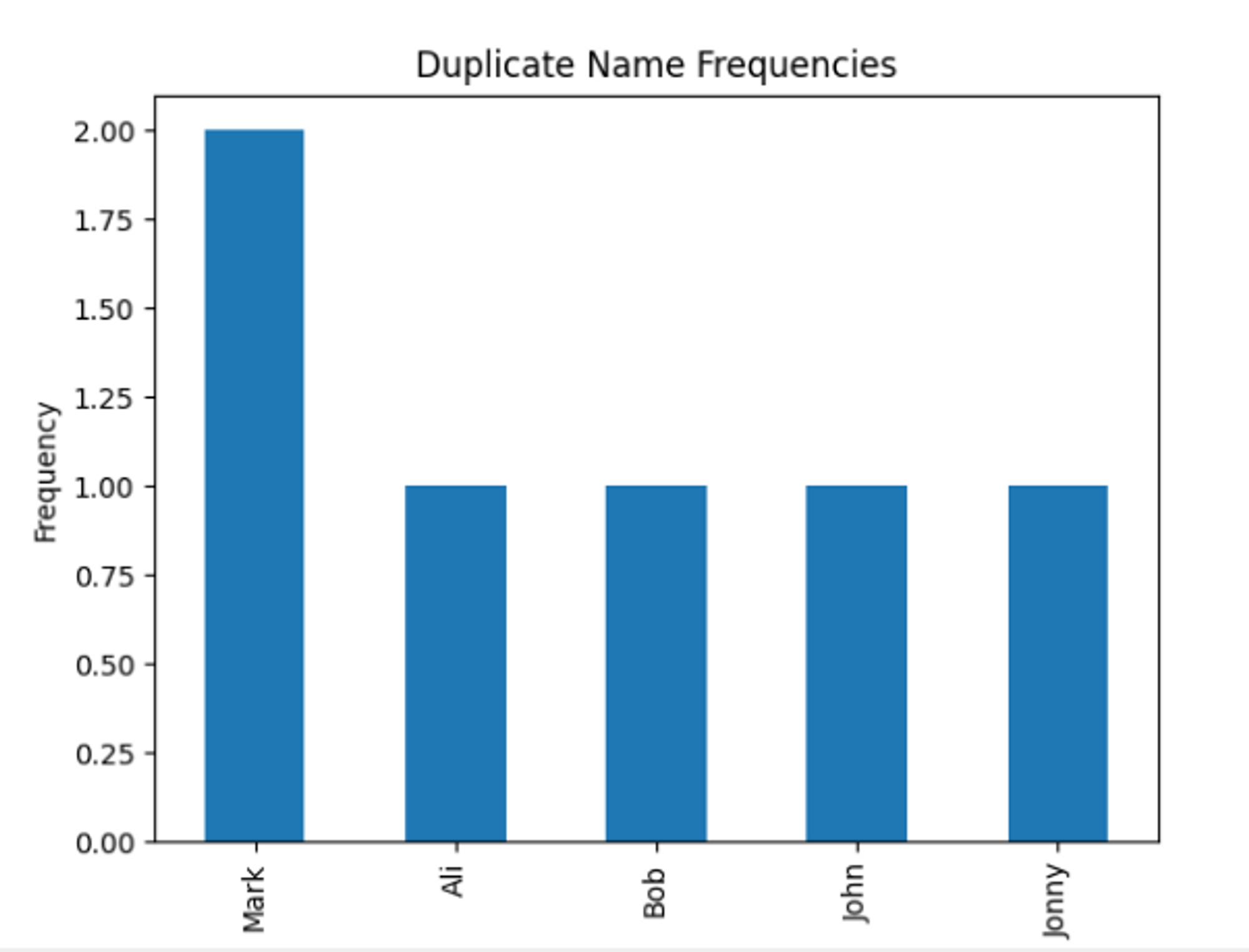
Handling Duplicate Values
After identifying duplicate values, it’s time to address them. In this section, we will explore various strategies for removing and updating duplicate values using the pandas drop_duplicates() and replace() functions. Additionally, we will discuss aggregating data with duplicate values using the groupby() function.
Removing Duplicate Values
The most common approach for handling duplicates is to remove them from the DataFrame. To eliminate duplicate records from the DataFrame, we will use the drop_duplicates() function. By default, this function keeps the first instance of each duplicate row and removes the subsequent occurrences. It identifies duplicate values based on all column values; however, we can specify the column to be considered using subset parameters.
Syntax of drop_duplicates() with default values in parameters is as follows:
dataFrame.drop_duplicates(subset=None, keep='first', inplace=False)
The subset and keep parameters have the same explanation as in duplicates(). If we set the third parameter inplace to True, all modifications will be performed directly on the original DataFrame, resulting in the method returning None and the original DataFrame being modified. By default, inplace is False.
Here is an example of the drop_duplicates() function:
df.drop_duplicates(keep='last', inplace=True)
print(df)
Output:
StudentName Score
1 Ali 65
2 Bob 76
3 John 44
4 Johny 39
5 Mark 45
Check out our hands-on, practical guide to learning Git, with best-practices, industry-accepted standards, and included cheat sheet. Stop Googling Git commands and actually learn it!
In the above example, the first entry was deleted since it was a duplicate.
Replace or Update Duplicate Values
The second method for handling duplicates involves replacing the value using the Pandas replace() function. The replace() function allows us to replace specific values or patterns in a DataFrame with new values. By default, it replaces all instances of the value. However, by using the limit parameter, we can restrict the number of replacements.
Here’s an example of using the replace() function:
df['StudentName'].replace('Mark', 'Max', limit=1, inplace=True)
print(df)
Output:
StudentName Score
0 Max 45
1 Ali 65
2 Bob 76
3 John 44
4 Johny 39
5 Mark 45
Here, the limit was used to replace the first value. What if we want to replace the last occurrence? In this case, we will combine the duplicated() and replace() functions. Using duplicated(), we will indicate the last instance of each duplicate value, obtain the row number using the loc function, and then replace it using the replace() function. Here’s an example of using duplicated() and replace() functions together.
last_occurrences = df.duplicated(subset='StudentName', keep='first') last_occurrences_rows = df[last_occurrences] df.loc[last_occurrences, 'StudentName'] = df.loc[last_occurrences, 'StudentName'].replace('Mark', 'Max') print(df)
Output:
StudentName Score
0 Mark 45
1 Ali 65
2 Bob 76
3 John 44
4 Johny 39
5 Max 45
Custom Functions for Complex Replacements
In some cases, handling duplicate values requires more intricate replacements than simply removing or updating them. Custom functions enable us to create specific replacement rules tailored to our needs. By using the pandas apply() function, we can apply the custom function to our data.
For example, let’s assume the “StudentName” column contains duplicate names. Our goal is to replace duplicates using a custom function that appends a number at the end of duplicate values, making them unique.
def add_number(name, counts): if name in counts: counts[name] += 1 return f'{name}_{counts[name]}' else: counts[name] = 0 return name name_counts = {} df['is_duplicate'] = df.duplicated('StudentName', keep=False)
df['StudentName'] = df.apply(lambda x: add_number(x['StudentName'], name_counts) if x['is_duplicate'] else x['StudentName'], axis=1)
df.drop('is_duplicate', axis=1, inplace=True)
print(df)
Output:
StudentName Score
0 Mark 45
1 Ali 65
2 Bob 76
3 John 44
4 Johny 39
5 Mark_1 45
Aggregate Data with Duplicate Values
Data containing duplicate values can be aggregated to summarize and gain insights from the data. The Pandas groupby() function allows you to aggregate data with duplicate values. By using the groupby() function, you can group one or more columns and calculate the mean, median, or sum of another column for each group.
Here’s an example of using the groupby() method:
grouped = df.groupby(['StudentName']) df_aggregated = grouped.sum()
print(df_aggregated)
Output:
Score
StudentName Ali 65
Bob 76
John 44
Johny 39
Mark 90
Advanced Techniques
To handle more complex scenarios and ensure accurate analysis, there are some advanced techniques that we can use. This section will discuss dealing with fuzzy duplicates, duplication in time series data, and duplicate index values.
Fuzzy Duplicates
Fuzzy duplicates are records that are not exact matches but are similar, and they may occur for various reasons, including data input mistakes, misspellings, and variations in formatting. We will use the fuzzywuzzy Python library to identify duplicates using string similarity matching.
Here is an example of handling fuzzy values:
import pandas as pd
from fuzzywuzzy import fuzz def find_fuzzy_duplicates(dataframe, column, threshold): duplicates = [] for i in range(len(dataframe)): for j in range(i+1, len(dataframe)): similarity = fuzz.ratio(dataframe[column][i], dataframe[column][j]) if similarity >= threshold: duplicates.append(dataframe.iloc[[i, j]]) if duplicates: duplicates_df = pd.concat(duplicates) return duplicates_df else: return pd.DataFrame() data = { 'StudentName': ['Mark', 'Ali', 'Bob', 'John', 'Johny', 'Mark'], 'Score': [45, 65, 76, 44, 39, 45]
}
df = pd.DataFrame(data) threshold = 70 fuzzy_duplicates = find_fuzzy_duplicates(df, 'StudentName', threshold)
print("Fuzzy duplicates:")
print(fuzzy_duplicates.to_string(index=False))
In this example, we create a custom function find_fuzzy_duplicates that takes a DataFrame, a column name, and a similarity threshold as input. The function iterates through each row in the DataFrame and compares it with subsequent rows using the fuzz.ratio method from the fuzzywuzzy library. If the similarity score is greater than or equal to the threshold, the duplicate rows are added to a list. Finally, the function returns a DataFrame containing the fuzzy duplicates.
Output:
Fuzzy duplicates:
StudentName Score Mark 45 Mark 45 John 44 Johny 39
In the above example, fuzzy duplicates are identified in the “StudentName” column. The ‘find_fuzzy_duplicates’ function compares each pair of strings using the fuzzywuzzy library’s fuzz.ratio function, which calculates a similarity score based on the Levenshtein distance. We’ve set the threshold at 70, meaning that any name with a match ratio greater than 70 will be considered a fuzzy value. After identifying fuzzy values, we can manage them using the method outlined in the section titled “Handling Duplicates.”
Handling Time Series Data Duplicates
Duplicates can occur when multiple observations are recorded at the same timestamp. These values can lead to biased results if not properly handled. Here are a few ways to handle duplicate values in time series data.
- Dropping Exact Duplicates: In this method, we remove identical rows using the
drop_duplicatesfunction in Pandas. - Duplicate Timestamps with Different Values: If we have the same timestamp but different values, we can aggregate the data and gain more insight using
groupby(), or we can select the most recent value and remove the others usingdrop_duplicates()with thekeepparameter set to ‘last’.
Handling Duplicate Index Values
Before addressing duplicate index values, let’s first define what an index is in Pandas. An index is a unique identifier assigned to each row of the DataFrame. Pandas assigns a numeric index starting at zero by default. However, an index can be assigned to any column or column combination. To identify duplicates in the Index column, we can use the duplicated() and drop_duplicates() functions, respectively. In this section, we will explore how to handle duplicates in the Index column using reset_index().
As its name implies, the reset_index() function in Pandas is used to reset a DataFrame’s index. When applying the reset_index() function, the current index is automatically discarded, which means the initial index values are lost. By specifying the drop parameter as False in the reset_index() function, we can retain the original index value while resetting the index.
Here is an example of using reset_index():
import pandas as pd data = { 'Score': [45, 65, 76, 44, 39, 45]
}
df = pd.DataFrame(data, index=['Mark', 'Ali', 'Bob', 'John', 'Johny', 'Mark']) df.reset_index(inplace=True)
print(df)
Output:
index Score
0 Mark 45
1 Ali 65
2 Bob 76
3 John 44
4 Johny 39
5 Mark 45
Best Practices
-
Understand Duplicate Data’s Nature: Before taking any action, it is crucial to comprehend why duplicate values exist and what they represent. Identify the root cause and then determine the appropriate steps to handle them.
-
Select an Appropriate Method for Handling Duplicates: As discussed in previous sections, there are multiple ways to handle duplicates. The method you choose depends on the nature of the data and the analysis you aim to perform.
-
Document the Approach: It is vital to document the process for detecting duplicate values and addressing them, allowing others to understand the thought process.
-
Exercise Caution: Whenever we remove or modify data, we must ensure that eliminating duplicates does not introduce errors or bias into the analysis. Conduct sanity tests and validate the results of each action.
-
Preserve the Original Data: Before performing any operation on data, create a backup copy of the original data.
-
Prevent Future Duplicates: Implement measures to prevent duplicates from occurring in the future. This can include data validation during data entry, data cleansing routines, or database constraints to enforce uniqueness.
Final Thoughts
In data analysis, addressing duplicate values is a crucial step. Duplicate values can lead to inaccurate results. By identifying and managing duplicate values efficiently, data analysts can derive precise and significant information. Implementing the mentioned techniques and following best practices will enable analysts to preserve the integrity of their data and extract valuable insights from it.
- SEO Powered Content & PR Distribution. Get Amplified Today.
- EVM Finance. Unified Interface for Decentralized Finance. Access Here.
- Quantum Media Group. IR/PR Amplified. Access Here.
- PlatoAiStream. Web3 Data Intelligence. Knowledge Amplified. Access Here.
- Source: https://stackabuse.com/handling-duplicate-values-in-a-pandas-dataframe/
- :has
- :is
- :not
- :where
- 1
- 11
- 12
- 20
- 70
- 8
- 9
- a
- above
- accurate
- Action
- actually
- added
- Additionally
- address
- addressing
- advanced
- After
- aggregating
- aim
- All
- Allowing
- allows
- among
- an
- analysis
- analyst
- Analysts
- and
- Another
- any
- appears
- Apply
- Applying
- approach
- appropriate
- ARE
- article
- AS
- assigned
- At
- automatically
- Backup
- bar
- based
- BE
- before
- being
- below
- BEST
- best practices
- bias
- biased
- bob
- border
- but
- by
- calculate
- calculates
- CAN
- case
- cases
- Cause
- Chart
- Checks
- Choose
- Cleaning
- Column
- Columns
- combination
- combine
- Common
- complex
- comprehend
- Conduct
- Consider
- considered
- considering
- constraints
- contains
- Corresponding
- create
- created
- crucial
- Current
- custom
- customization
- data
- data analysis
- data entry
- Database
- dealing
- Default
- depends
- described
- Detection
- Determine
- different
- directly
- discuss
- discussed
- distance
- document
- does
- don
- duplicates
- during
- each
- effectively
- efficient
- efficiently
- element
- eliminate
- eliminating
- enable
- enables
- end
- enforce
- ensure
- entry
- equal
- Errors
- example
- Except
- exist
- explanation
- explore
- extract
- few
- Finally
- First
- Focus
- following
- follows
- For
- Frequency
- from
- function
- functions
- future
- Gain
- generated
- Git
- goal
- graph
- greater
- Group
- guide
- handle
- Handling
- hands-on
- Have
- here
- hover
- How
- How To
- However
- HTTPS
- i
- identical
- identified
- identifier
- identifies
- identify
- identifying
- if
- implement
- implementing
- important
- in
- inaccurate
- include
- included
- Including
- index
- indicate
- indicates
- information
- initial
- input
- insight
- insights
- instance
- integrity
- into
- introduce
- Introduction
- invoked
- issues
- IT
- ITS
- John
- Keep
- Labels
- Last
- lead
- LEARN
- learning
- Length
- let
- LG
- Library
- LIMIT
- List
- lost
- Making
- manage
- managing
- mark
- marked
- Match
- matching
- matplotlib
- max
- May..
- mean
- meaning
- means
- measures
- mentioned
- method
- methods
- mistakes
- Modifications
- modified
- modify
- more
- most
- multiple
- must
- name
- names
- Nature
- needs
- New
- now
- number
- obtain
- occurring
- of
- Offers
- on
- ONE
- operation
- Option
- Options
- or
- original
- Other
- Others
- our
- out
- outlined
- output
- pair
- pandas
- parameter
- parameters
- patterns
- Perform
- performed
- performing
- plato
- Plato Data Intelligence
- PlatoData
- plays
- possible
- potentially
- Practical
- practices
- precise
- prevent
- previous
- process
- properly
- provide
- Python
- ratio
- reasons
- recent
- recorded
- records
- remove
- removing
- replace
- replacement
- represent
- representing
- requires
- respectively
- responsibility
- restrict
- resulting
- Results
- retain
- returning
- returns
- Ring
- Role
- root
- ROW
- rules
- s
- same
- scenarios
- score
- Second
- Section
- sections
- Series
- set
- Shadow
- sheet
- should
- significant
- similar
- Simple
- simply
- since
- some
- specific
- Stackabuse
- standards
- Starting
- Step
- Steps
- Stop
- strategies
- String
- Student
- Students
- subsequent
- summarize
- tailored
- takes
- taking
- techniques
- tests
- than
- that
- The
- The Future
- their
- Them
- then
- There.
- therefore
- These
- they
- Third
- this
- thought
- threshold
- Through
- time
- Time Series
- times
- timestamp
- titled
- to
- together
- Total
- transition
- trustworthy
- two
- understand
- unique
- uniqueness
- Update
- updating
- us
- use
- used
- using
- VALIDATE
- validation
- Valuable
- value
- Values
- various
- Ve
- vital
- want
- was
- ways
- we
- WELL
- What
- when
- whenever
- whether
- which
- while
- why
- will
- with
- within
- X
- You
- zephyrnet
- zero


